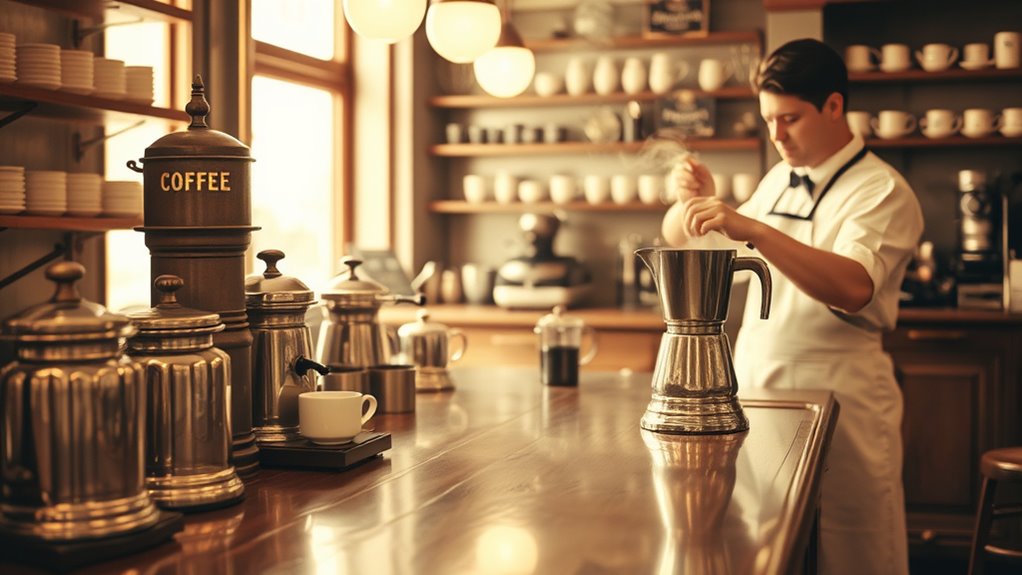In the 20th century, coffee transformed from a daily routine into a cultural icon thanks to innovations like instant coffee and espresso machines, which made brewing easier. During wartime, coffee boosted morale and became a symbol of comfort. After WWII, caffeine became a staple across America, sparking a vibrant coffee scene and the rise of specialty cafes. If you continue exploring, you’ll uncover how these changes shaped coffee’s worldwide influence today.
Key Takeaways
- Technological innovations like instant coffee (1909) and freeze-dried coffee (1938) increased convenience and global accessibility.
- During WWII, coffee was rationed for soldiers, strengthening its role as a morale booster and symbol of normalcy.
- Post-war America saw a coffee boom with brands like Folger’s and Maxwell House becoming everyday staples.
- Coffee culture evolved with the rise of espresso machines and coffee houses, emphasizing craftsmanship and community.
- The specialty coffee movement focused on sourcing, roasting, and quality, transforming coffee into a cultural and lifestyle icon.

Have you ever wondered how coffee transformed into the everyday staple we enjoy today? The 20th century saw remarkable changes that made coffee more accessible, convenient, and culturally significant.
It all started with the development of instant coffee by George Constant Washington in 1909. This innovation revolutionized coffee consumption, allowing people to enjoy a quick cup without brewing traditional methods.
The invention of instant coffee by George Constant Washington in 1909 revolutionized consumption with quick, easy brewing.
Later, in 1938, Nestlé introduced freeze-dried coffee under the Nescafé brand, which became a global leader in instant coffee. This breakthrough made coffee even more convenient and helped it reach households worldwide, fueling its rise in popularity.
During World War II, coffee took on new importance. Soldiers received rationed supplies of coffee to boost morale during tough times, embedding coffee deeper into military and civilian life. The war’s impact on coffee consumption was significant, as it became a symbol of comfort and normalcy amid chaos.
Post-war, coffee’s popularity surged in America, thanks in part to the rise of well-known coffee brands like Folger’s and Maxwell House. These brands became household staples, making coffee an integral part of daily routines across the nation.
The 1940s also marked a major leap in coffee culture with the perfection of the modern espresso machine by Achille Gaggia in Italy in 1946. This invention introduced the crema and elevated coffee from simple beverage to an art form, inspiring a new appreciation for quality coffee.
Coffee houses blossomed as social hubs, where people gathered to enjoy expertly brewed espresso and discuss ideas. This era marked the beginning of a broader coffee culture that would expand globally, emphasizing craftsmanship and flavor.
Throughout the century, the rise of coffee roasters and specialty cafes helped shape a vibrant coffee scene. Coffee roasters refined the art of sourcing and roasting beans, emphasizing quality and origin.
Meanwhile, the increasing popularity of coffeehouses fostered a social scene that celebrated coffee as more than just a drink—it’s a way to connect, relax, and enjoy life.
With the advent of instant coffee, freeze-dried options, and sophisticated brewing machines, coffee’s accessibility grew exponentially. Its cultural significance was solidified through its role in social interactions, workplaces, and homes.
Frequently Asked Questions
What Two Events in the 20TH Century Were Significant in Coffee Becoming a Highly Popular Drink?
You’re asking about two key events that made coffee hugely popular in the 20th century. First, the invention and mass production of instant coffee in 1909, along with Nescafé’s marketing in 1938, made coffee easy and quick to prepare, boosting its popularity.
Second, the rise of television advertising after 1956 played a major role, as it promoted coffee brands directly to consumers, turning coffee into a household staple worldwide.
Did People Drink Coffee in the 1920S?
Yes, you drank coffee in the 1920s, especially in cities like New York and Chicago. Coffeehouses were popular social spots, and many Americans turned to coffee during Prohibition as a non-alcoholic beverage.
Instant coffee gained popularity, and advertising highlighted its convenience and modern appeal. You’d find coffee served regularly at home and work, making it a staple in everyday life during that vibrant decade.
When Did Coffee First Appear in History?
You wonder when coffee first appeared in history. It originated in Ethiopia during the 9th century, with legends about goat herders like Kaldi discovering its energizing effects.
By the 10th century, it was called “bunchum” in Persian texts.
Coffee then spread to the Islamic world in Yemen in the 15th century, and later entered Europe in the late 16th century through traders, becoming a global beverage.
Was the Biggest Producer of Coffee in the 19TH and Early 20TH Centuries?
You might be surprised to learn that Brazil was the biggest coffee producer in the 19th and early 20th centuries. By 1852, it became the world’s leading exporter, supplying around 97% of global coffee in 1908.
Its dominance came from extensive cultivation and technological advancements. While Colombia and Ethiopia grew in importance later, Brazil’s vast output shaped the global coffee industry, making it the top producer during that time.
Conclusion
By now, you’ve seen how coffee transformed throughout the 20th century, shaping cultures and economies worldwide. From innovations like instant coffee to the rise of specialty brews, you’ve witnessed its evolution. Coffee became more than just a drink; it became a daily ritual for millions. As you continue to enjoy your coffee, remember its rich history and the global journey that brought each cup to your hands. Cheers to coffee’s remarkable century-long story!









